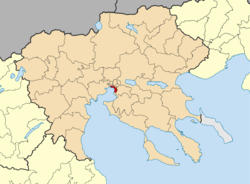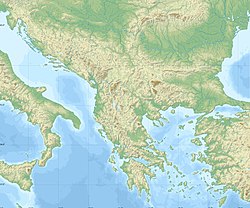
Back Thessaloniki Afrikaans Thessaloniki ALS Tesalonica AN سالونيك Arabic سالونيك ARZ Tesalónica AST Saloniki Azerbaijani Салоники Bashkir Thessaloniki BAN Tessalonik BBC
Thessaloniki
Θεσσαλονίκη Saloniki | |
|---|---|
|
| |
| Nickname: | |
 Location of the Municipality of Thessaloniki within Central Macedonia | |
| Coordinates: 40°38′25″N 22°56′8″E / 40.64028°N 22.93556°E | |
| Country | |
| Geographic region | |
| Administrative region | Central Macedonia |
| Regional unit | Thessaloniki |
| Founded | 315 BC (2340 years ago) |
| Incorporated | October 1912 (112 years ago) |
| Municipalities | 7 |
| Government | |
| • Type | Mayor–council government |
| • Mayor | Stelios Angeloudis[2] (PASOK) |
| Area | |
| 19.307 km2 (7.454 sq mi) | |
| • Urban | 111.703 km2 (43.129 sq mi) |
| • Metro | 1,285.61 km2 (496.38 sq mi) |
| Highest elevation | 250 m (820 ft) |
| Lowest elevation | 0 m (0 ft) |
| Population (2021)[5] | |
| 319,045 | |
| • Rank | 2nd urban, 2nd metro in Greece |
| • Urban | 802,572[3][4] |
| • Metro | 1,006,112[3] |
| Demonym(s) | Thessalonian, Thessalonican |
| Time zone | UTC+2 (EET) |
| • Summer (DST) | UTC+3 (EEST) |
| Postal codes | 53xxx, 54xxx, 55xxx, 56xxx |
| Area code | 2310 |
| Vehicle registration | NA to NX |
| Patron saint | Saint Demetrius (26 October) |
| Gross regional domestic product (PPP 2015) | €18.77 billion ($20.83 billion)[6] |
| • Per capita | €16,900[6] |
| Website | www.thessaloniki.gr |
Thessaloniki (/ˌθɛsələˈniːki/; Greek: Θεσσαλονίκη [θesaloˈnici] ⓘ), also known as Thessalonica (English: /ˌθɛsələˈnaɪkə, ˌθɛsəˈlɒnɪkə/), Saloniki, Salonika, or Salonica (/səˈlɒnɪkə, ˌsæləˈniːkə/), is the second-largest city in Greece, with slightly over one million inhabitants in its metropolitan area, and the capital of the geographic region of Macedonia, the administrative region of Central Macedonia and the Decentralized Administration of Macedonia and Thrace.[7][8] It is also known in Greek as i Symprotévousa, literally "the co-capital",[9] a reference to its historical status as the "co-reigning" city (Symvasilévousa) of the Byzantine Empire alongside Constantinople.[10]
Thessaloniki is located on the Thermaic Gulf, at the northwest corner of the Aegean Sea. It is bounded on the west by the delta of the Axios. The municipality of Thessaloniki, the historical centre, had a population of 319,045 in 2021,[5] while the Thessaloniki metropolitan area had 1,006,112 inhabitants and the greater region had 1,092,919.[4][3] It is Greece's second major economic, industrial, commercial and political centre, and a major transportation hub for Greece and southeastern Europe, notably through the Port of Thessaloniki.[11] The city is renowned for its festivals, events and vibrant cultural life in general.[12] Events such as the Thessaloniki International Fair and the Thessaloniki International Film Festival are held annually. Thessaloniki was the 2014 European Youth Capital. The city's main university, Aristotle University, is the largest in Greece and the Balkans.[13]
The city was founded in 315 BC by Cassander of Macedon, who named it after his wife Thessalonike, daughter of Philip II of Macedon and sister of Alexander the Great. It was built 40 km southeast of Pella, the capital of the Kingdom of Macedonia. An important metropolis by the Roman period, Thessaloniki was the second largest and wealthiest city of the Byzantine Empire. It was conquered by the Ottomans in 1430 and remained an important seaport and multi-ethnic metropolis during the nearly five centuries of Turkish rule, with churches, mosques, and synagogues co-existing side by side. From the 16th to the 20th century it was the only Jewish-majority city in Europe. It passed from the Ottoman Empire to the Kingdom of Greece on 8 November 1912. Thessaloniki exhibits Byzantine architecture, including numerous Paleochristian and Byzantine monuments, a World Heritage Site, and several Roman, Ottoman and Sephardic Jewish structures.
In 2013, National Geographic Magazine included Thessaloniki in its top tourist destinations worldwide,[14] while in 2014 Financial Times FDI magazine (Foreign Direct Investments) declared Thessaloniki as the best mid-sized European city of the future for human capital and lifestyle.[15][16]
- ^ Soloman, Esther; Galiniki, Styliana (2018). "13: Las Incantadas of Salonika: searching for 'enchantment' in a city's exiled heritage". Hellenomania. New York: Routledge.
- ^ Municipality of Thessaloniki, Municipal elections – October 2023, Ministry of Interior
- ^ a b c Thessaloniki is an urban area defined in 1985 through Law 1561/1985. Since the Kallikratis reform it has been made up of the municipalities of Thessaloniki (325,182), Kalamaria (91,518), Neapoli–Sykies (84,741), Pavlos Melas (99,245), Kordelio–Evosmos (101,753), Ampelokipoi–Menemeni (52,127), and the municipal units of Pylaia and Panorama (34,625 and 17,444; part of the municipality of Pylaia–Chortiatis). The Thessaloniki metropolitan area was defined by the same law and is made up of the urban area plus the municipalities of Delta (45,839), Oraiokastro (38,317), Thermaikos (50,264), Thermi (53,201), and the municipal unit of Chortiatis (18,041; part of the municipality of Pylaia–Chortiatis), for a total of 1,030,338. See Εφημερίς της Κυβερνήσεως της Ελληνικής Δημοκρατίας [Government Gazette of the Hellenic Republic] (in Greek). Athens: National Printing House. 6 September 1985. p. 2332. Archived from the original on 27 February 2021. Retrieved 10 February 2019.
- ^ a b "Μόνιμος Πληθυσμός - ELSTAT". www.statistics.gr. Archived from the original on 5 January 2023. Retrieved 10 June 2023.
- ^ a b Cite error: The named reference
2021censuswas invoked but never defined (see the help page). - ^ a b "Gross domestic product (GDP) at current market prices at NUTS level 3". Eurostat. Archived from the original on 28 January 2019. Retrieved 27 January 2019.
- ^ Greek Republic 2011, p. 22, Έδρα της περιφέρειας Κεντρικής Μακεδονίας είναι η Θεσσαλονίκη. (The capital of the region of Central Macedonia is Thessaloniki.)
- ^ Greek Republic 2011, p. 25, Αποκεντρωμένη Διοίκηση Μακεδονίας – Θράκης, η οποία εκτείνεται στα όρια της περιφέρειας Ανατολικής Μακεδονίας – Θράκης και Κεντρικής Μακεδονίας, με έδρα την Θεσσαλονίκη. ([The creation of the] Decentralized Administration of Macedonia-Thrace, which includes the modern regions of East Macedonia-Thrace and Central Macedonia, with Thessaloniki as capital
- ^ Harry Coccossis; Yannis Psycharis (2008). Regional analysis and policy: the Greek experience. Springer. p. 19. ISBN 9783790820867. Archived from the original on 15 March 2024. Retrieved 19 August 2011.
- ^ Manos G. Birēs; Marō Kardamitsē-Adamē (2004). Neoclassical architecture in Greece. Getty Publications. p. 176. ISBN 9780892367757. Retrieved 10 August 2011.
Thessaloniki.
- ^ Nicholas Konsolas; Athanassios Papadaskalopoulos; Ilias Plaskovitis (2002). Regional development in Greece. Springer. ISBN 9783540423959. Archived from the original on 15 March 2024. Retrieved 16 August 2011.
- ^ "Introducing Thessaloniki". Lonely Planet travel guides. Archived from the original on 9 February 2009. Retrieved 19 August 2011.
- ^ "Aristotle University of Thessaloniki". European University Foundation. Archived from the original on 16 February 2024. Retrieved 16 February 2024.
- ^ "Best Trips 2013 – Thessaloniki". National Geographic. December 2012. Archived from the original on 30 November 2012. Retrieved 6 January 2013.
- ^ "Η Θεσσαλονίκη αναδείχθηκε σε ευρωπαϊκή πόλη του μέλλοντος για το 2014 | ΕΛΛΑΔΑ | ΕΙΔΗΣΕΙΣ | LiFO". lifo.gr. 17 February 2014. Archived from the original on 25 December 2014. Retrieved 7 December 2014.
- ^ "European Cities and Regions of the Future 2014/15" (PDF). 17 February 2014. Archived (PDF) from the original on 9 October 2022. Retrieved 7 December 2014.











